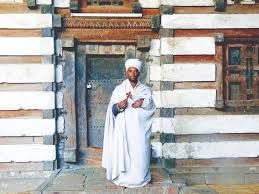Ethiopia is a country with one of the richest histories on the African continent, land of contrast surprises, of remote and wild places home to cultured and friendly people who descended from some of the world’s oldest civilizations.
In this week’s peek edition we would like to take you to a cave church in Northern Amhara State Yemrehena Kirstos. Situated about 40 km from the 8th world wonder Lalibela, the church is believed to have been built in the 11th and 12th century which makes it the oldest from in the 11 medieval monolithic cave and single rock hewn churches found in Lalibela.
Read More: Ethiopia Launches MICE Tourism Brand
The church complex of Yemrehanna Kiristos is among the most important and impressive heritage sites in Ethiopia. It was named after a king of Ethiopia during the Zagwe Dynasty known as Saint Yemrehena Kirstos who ruled for over 40 years. The church was built above a water underneath a cave.
According to Taddesse Tamrat an Ethiopian historian and scholar of Ethiopian studies and also the author of the book ‘Church and state in Ethiopia’ Yemerehana Kirstos was the son of Germa Seyum and he was the successor of Na’akueto La’ab succeeded by Yetbarak.
Read More: Border Re-Opened; Welcome to Ethiopia, the Land of Origins
Taddesse in his book describes him as the king of Ethiopia closest to a priest, as he insisted on ruling Ethiopia according to apostolic canons. It was Yemrehana Kirstos who began the tradition of confining rival heir to the imperial throne at Amba Geshen.
The complex consists of a church, a palace, store with tomb of king Yemrehana Kristos and an ossuary containing the desiccated remains of pilgrims. The palace is the only free standing secular medieval building to survive in the Axumite style in Ethiopia.All the elements of the complex are located inside a large cave, which is part natural and part hewn from dense black basalt that makes up the mountainside. At its deepest, the cave is 53metres deep and for the most part 7 to 8 metres high. Its entrance is concealed behind a modern wall. The site is located at the end of a long juniper-lined valley nestled deep within the rugged Lasta Mountains, close to the village of Yemrehana Kirstos.
The whole church sits on a foundation of carefully laid olive wood panels, which float it perfectly above the water ground. The carving and decoration are exceptional especially the ceiling elaborates cross stars and animals and different designs.
Read More:የሀገር ውስጥ ጉዞንና ጉብኝትን ማሳደግ ለኢትዮጵያ ህልውናም ወሳኝ ነው
The church is made of wood and plaster. Inside the church, the walls are covered in wood panelling. There are also tall wooden arches which have delicate designs. Behind the church lies a pile of five thousand mummified skeletons that were incremented into a mummy before 10 years standing and not laid on their side.
The king’s place is also found there filled with gifts and donations from people and friends.Unlike the churches in Lalibela which are carved out of rock, the palace church and store are constructed from timber, stone and gypsum plaster. The walls contain wooden frames, and are built with alternate bands of timber and stone finished with plaster. The church is richly carved and decorated inside. Some of its internal walls are painted with remarkable murals depicting scenes from the New Testament, dating from the early part of the 12th century.
Regarding the complex, scholars generally agree that the painting are the earliest surviving wall paintings in Ethiopia. They are considered highly significant because of their early date, their survival as a composite whole, the technical sophistication of the work, and for their quality and naturalist style, reflecting Coptic, Arabo- Christian and other influences, which is quite different from most other medieval wall paintings in Ethiopia. The church and palace stand at a critical stage in the development of post- Axumite architecture. The palace is perhaps the earliest surviving secular building in Ethiopia, and the only secular building in the post Axumite style.
Priests and monks still live in the church cave and the church is still frequented by pilgrims that go to the church to die, where their remains rest in the cave behind the building.
Since 2000, the monastery has been accessible by a muddy alley road and it is becoming a popular destination for tourists. The site was also included on the 2014 world monuments watch to draw attention to the site’s importance and conservation needs. If you’re in Yemharena Kritos church around October 19, in Ethiopian calendar, the site throngs with pilgrims and is an unforgettable experience.
Source: The Ethiopian Herald
Follow Afro Travel Blogs for more updates and Book Your Ethiopia Trip with Afro Experience.
Ethiopia Travel Advice:
Ethiopia entry requirement in relation to covid-19 effective 23 September 2020(Taken from Ethiopian Airlines) All passengers traveling to Ethiopia MUST present a negative RT PCR test certificate for COVID-19 before boarding a flight. The certificate validity shouldn’t exceed 120 hours on arrival from the date sample is given. Children less than or equal to 12 years of age are exempted from the RT PCR test certificate requirement. There shall be no COVID-19 test to be done on arrival at Addis Ababa. A Rapid diagnostic test (RDT antibody test) will not be accepted for this purpose. The above requirement does not apply to transit passengers. All Diplomatic and Service (including United Nations and African Union) passport holders, including their immediate families, are advised but not required to have a certificate of negative PCR-COVID-19 test before arrival to Ethiopia. However, anyone (diplomatic and service passport holder including their immediate families) who come to Ethiopia without negative PCR COVID-19 test result, is required to stay in quarantine for fourteen (14) days at home.

